Comments / Questions (29)
![]() Luisa Consuelo wrote:
Luisa Consuelo wrote:
Los números q aparecen son números de puntos o centímetros?
15.05.2024 - 03:58DROPS Design answered:
Hola Luisa, los números en el texto serán cm o pts, siempre se indicarán. Siempre que sean cm se indican con cm después de los números. Los números en el esquema de la prenda son cm.
19.05.2024 - 23:01
![]() Aurelie wrote:
Aurelie wrote:
Bonjour , le modèle présenté peut être tricoter avec la laine drops eskimo ? MERCI DE VOTRE REPONSE
10.11.2017 - 19:57DROPS Design answered:
Bonjour Aurélie, ce modèle peut se tricoter avec 1 autre fil du groupe A et 1 autre fil du groupe C (type Brushed Alpaca Silk), mais pas avec un fil du groupe E comme Eskimo. Vous trouverez plus d'infos sur les alternatives ici. Bon tricot!
13.11.2017 - 11:43Diane wrote:
Avec quelle autre sorte de fil peut on faire ce chandail? Je veux dire si on en prend seulement un. Merci..
26.04.2014 - 01:35DROPS Design answered:
Bonjour Diane, cliquez ici pour trouver toutes les qualités DROPS classées par groupe et les équivalences possibles. Votre magasin DROPS saura également vous conseiller. Bon tricot!
26.04.2014 - 10:00Brygida Jurczyk wrote:
Vielen Dank fuer die schnelle Antwort ,also mache ich weiter! Muster ist ja super und garn toll!
19.11.2013 - 12:31Brygida Jurczyk wrote:
Ich habe eine Frage zur Anleitung von Nr. 126-35:was heisst 2 R "so" stricken ( wieder Muster wiederholen oder wie die Maschen vom Nadelfallen). Bitte beantworten Sie mir die Frage bald, sonst bleibe ich mit der Arbeit stehen!!! Vielen Dank!!!
18.11.2013 - 17:46DROPS Design answered:
Liebe Brygida, 2 R. so stricken bedeutet 2 R so stricken, wie es gerade beschrieben wurde.
19.11.2013 - 09:17
![]() Steck Karin wrote:
Steck Karin wrote:
Ich habe eine Frage zur Anleitung von Nr. 126-35. Ist die Jacke mit Doppelfaden gestrickt (von jeder Wollart)? Bitte teilen Sie mir dies bald mit, dass ich anfangen kann zu stricken!! Danke!
11.02.2013 - 21:02DROPS Design answered:
Guten Tag Frau Steck, die Jacke wird mit 1 Faden jeder Qualität gestrickt (siehe 1. Zeile in der Anleitung).
12.02.2013 - 11:47
![]() Joyce wrote:
Joyce wrote:
Hoi, Kijk misschien niet goed, maar ik kan telpatroon m2 nergens terugvinden. Als ik naar de foto kijk, lijkt het of het boord ook uit ruches bestaat, maar dit vind ik niet in de beschrijving. Tevens is me niet duidelijk uit de tekening hoe breed voorpand en achterpand samen zijn. Dit om te bepalen welke maat nodig is.
16.01.2013 - 13:10DROPS Design answered:
Telpatroon M.2 staat onderaan het patroon net onder M.1. Je maakt ruches langs de onderkant/boord door de minderingen te maken in het patroon. Wij geven alleen de afmeting weer voor het achterpand omdat de voorpanden los moeten hangen. Maar gebruik de stekenverhouding om de breedte te berekenen.
16.01.2013 - 16:05
![]() DROPS Design wrote:
DROPS Design wrote:
If you need support, we kindly ask you to go to the shop where you bought the yarn. When you buy original Garnstudio yarn, you can be sure that you have bought yarn from a shop that will give you all the help you may need also by phone or email.
30.08.2011 - 09:19
![]() Lisa wrote:
Lisa wrote:
Ruffle edge instructions are vague. Drops patterns tend toward vagueness anyway. Will have to do it my way since I can't write a long enough message to clarify...
30.08.2011 - 03:06
![]() Lisa wrote:
Lisa wrote:
I would LOVE to be able to ask you a question about the vagueness of this pattern but apparently even keeping it to a minimum is too long for your system. FRUSTRATING!!!!!!!
30.08.2011 - 03:04
Gypsy Charm#gypsycharmcardigan |
||||||||||
 |
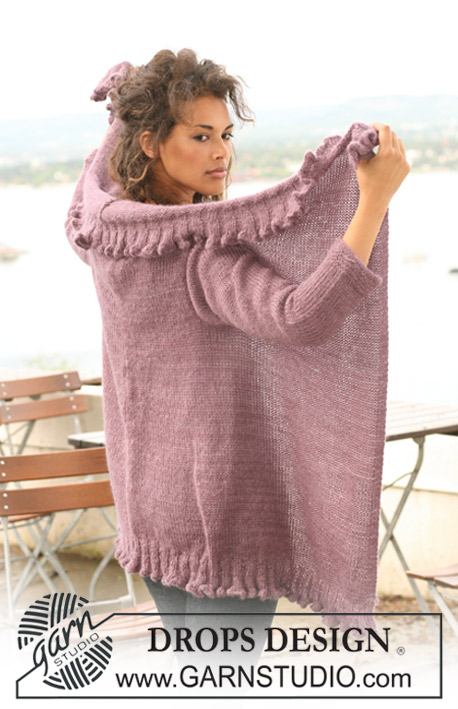 |
|||||||||
Knitted DROPS jacket in ”Alpaca” and ”Vivaldi” with flounces. Size S to XXXL
DROPS 126-35 |
||||||||||
|
INCREASING TIP: Inc 1 st by making 1 YO. On next row K YO into back of loop to avoid a hole. GARTER ST (back and forth on needle): K all rows. PATTERN: See diagram M.1 and M.2. Diagram shows the pattern from RS. -------------------------------------------------------- JACKET: Worked back and forth on circular needle. Cast on 827-899-953-1025-1133-1223 sts on circular needle size 4.5 mm with 1 strand of each quality (= 2 strands). K 1 row from WS and continue as follows from RS: 4 garter sts, K9, * P9/K9 *, repeat from *-* and finish with 4 garter sts. Work 2 rows like this, on next row (from RS) K2 tog on the first 8 sts in each K/P section = 463-503-533-573-633-683 sts. Work 1 row in rib K5/P5 with 4 garter sts each side. On next row K2 tog on the first 4 sts in each K/P section = 281-305-323-347-383-413 sts. Work 2 cm rib K3/P3 with 4 garter sts each side. On next row from RS dec 1 st in each K-section = 235-255-270-290-320-345 sts. Work 1 row rib K2/P3 – as seen from RS. On next row (= RS) dec 1 st in each P-section = 190-206-218-234-258-278 sts. Work 2 cm rib K2 /P2 with 4 garter sts each side. Change to circular needle size 5 mm, and continue in stocking st with 4 garter sts each side. Piece now measures 8 cm. Insert a marker after 95-103-109-117-129-139 sts (= mid back). When piece measures 10 cm dec 1 st each side of marker, repeat the dec on every 11-12-12-12-13-13 cm a total of 4 times = 182-198-210-226-250-270 sts. When piece measures 49-50-51-52-53-54 cm divide for armhole as follows – from RS: RIGHT FRONT PIECE: Slip the last 127-142-153-168-191-210 sts on a stitch holder, and only work the first 55-56-57-58-59-60 sts. Work stocking st with 4 garter sts at the side until piece measures 69-71-73-75-77-79 cm. Put piece aside. LEFT FRONT PIECE: Slip the last 55-56-57-58-59-60 sts left on needle, work like right front piece. BACK PIECE: Slip the remaining 72-86-96-110-132-150 sts back on needle. Cast off 6-12-16-22-32-40 sts at the beg off the next 2 rows each side for armhole = 60-62-64-66-68-70 sts. Work stocking st until piece measures 69-71-73-75-77-79 cm. Slip all sts back on the same needle = 170-174-178-182-186-190 sts. Work stocking st until piece measures 89-91-93-95-97-99 cm. Change to circular needle size 4.5 mm, and continue in rib as follows – from RS: * K2, P2 * with 4 garter sts each side. When piece measures 2 cm inc 1 st in each P-section – see INCREASING TIP! = 210-215-220-225-230-235 sts. Continue in rib K2/P3 – as seen from RS - for 1 cm. On next row inc 1 st in each K-section – see INCREASING TIP! = 251-257-263-269-275-281 sts. Continue in rib K3/ P3 for 2 cm. On next row work M.1 on all sts (garter sts each side as before) = 413-423-433-443-453-463 sts. Work 1 row K5/P5. On next row work M.2 on all sts (garter sts each side as before) = 737-755-773-791-809-827 sts. Work 1 row K9/P9. Cast off loosely with K over K and P over P. Piece measures approx 97-99-101-103-105-107 cm. SLEEVE: Worked back and forth on needle. Cast on 40-42-42-44-46-48 sts (includes 1 edge st each side) on circular needle size 5 mm with 1 strand of each quality (= 2 strands). Work garter st. When piece measures 4 cm continue in stocking st. When piece measures 8 cm inc 1 st each side, repeat the inc on every 4-3.5-3-2.5-2-2 cm a total of 10-11-13-14-16-17 times = 60-64-68-72-78-82 sts. When piece measures 49-49-48-48-46-45 cm - NOTE: Less for the larger sizes because of longer sleeve cap and wider shoulder- cast off for sleeve cap at the beg of every row each side as follows: 3 sts 1 time, 2 sts 3 times, 1 st 0-1-2-3-5-7 times, then 2 sts each side until piece measures 55-56-56-57-57-58 cm, now cast off 3 sts 1 time each side, and cast off remaining sts. Piece measures approx 56-57-57-58-58-59 cm. ASSEMBLY: Set in sleeves and sew under arm seams. |
||||||||||
Diagram explanations |
||||||||||
|
||||||||||
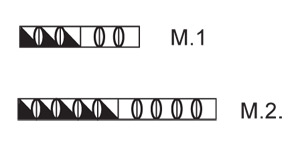
|
||||||||||
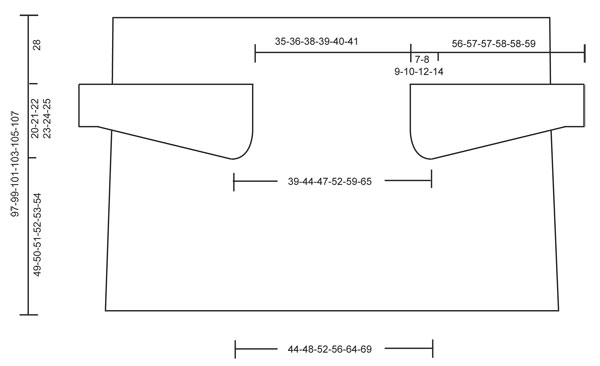
|
||||||||||
Have you finished this pattern?Tag your pictures with #dropspattern #gypsycharmcardigan or submit them to the #dropsfan gallery. Do you need help with this pattern?You'll find 19 tutorial videos, a Comments/Questions area and more by visiting the pattern on garnstudio.com. © 1982-2025 DROPS Design A/S. We reserve all rights. This document, including all its sub-sections, has copyrights. Read more about what you can do with our patterns at the bottom of each pattern on our site. |
||||||||||








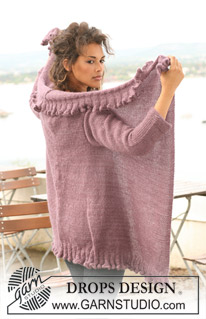



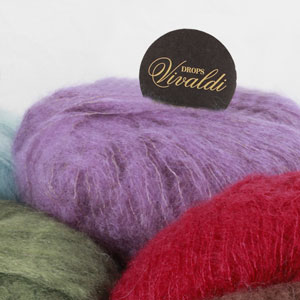















































Post a comment to pattern DROPS 126-35
We would love to hear what you have to say about this pattern!
If you want to leave a question, please make sure you select the correct category in the form below, to speed up the answering process. Required fields are marked *.